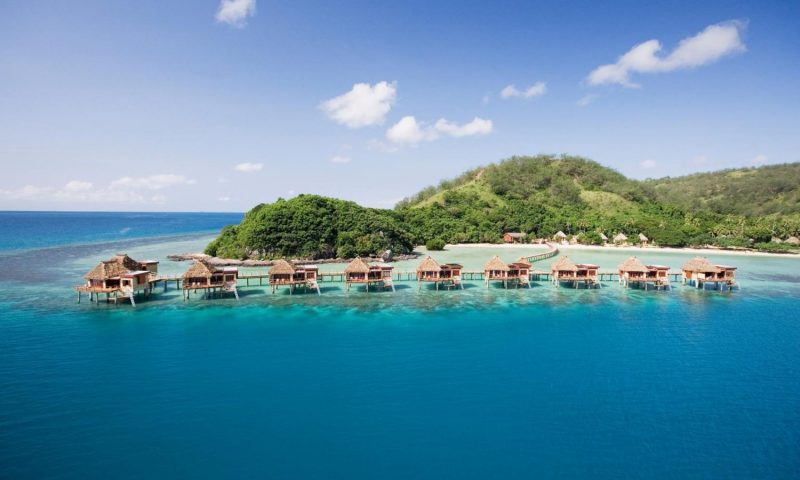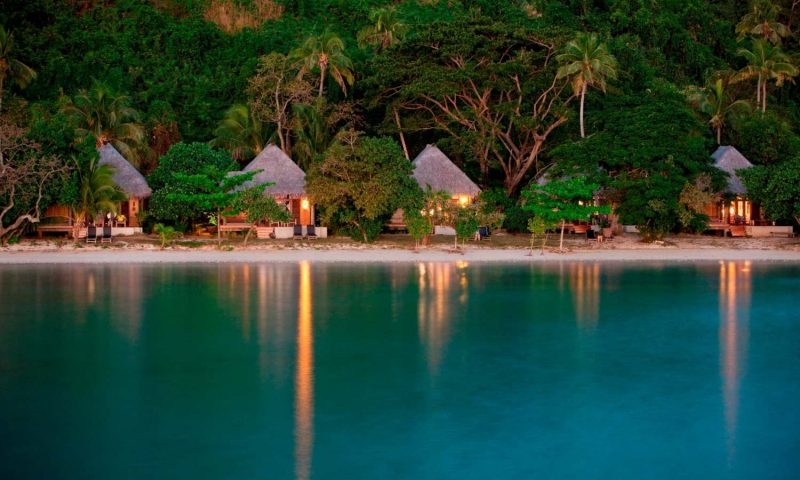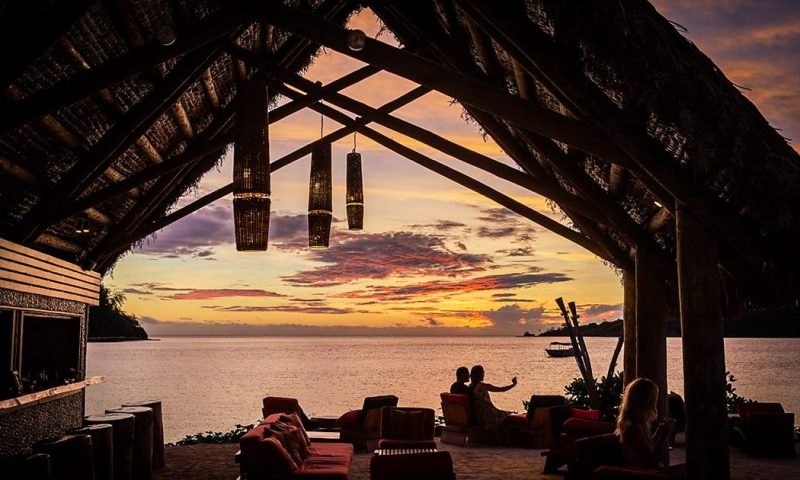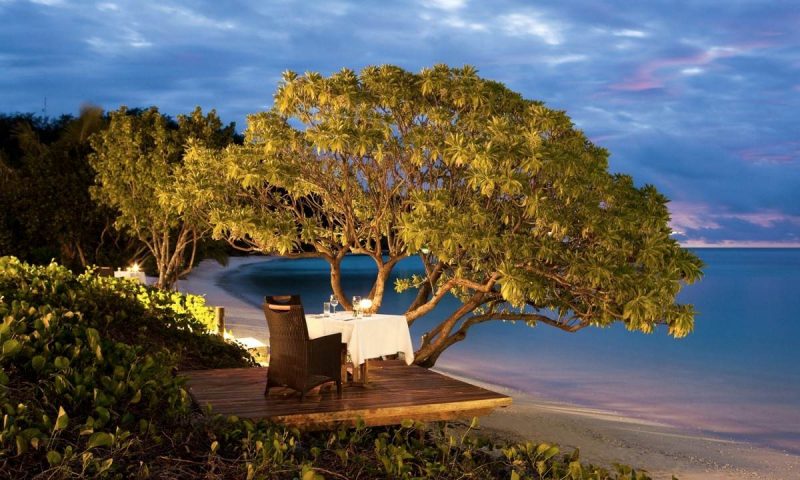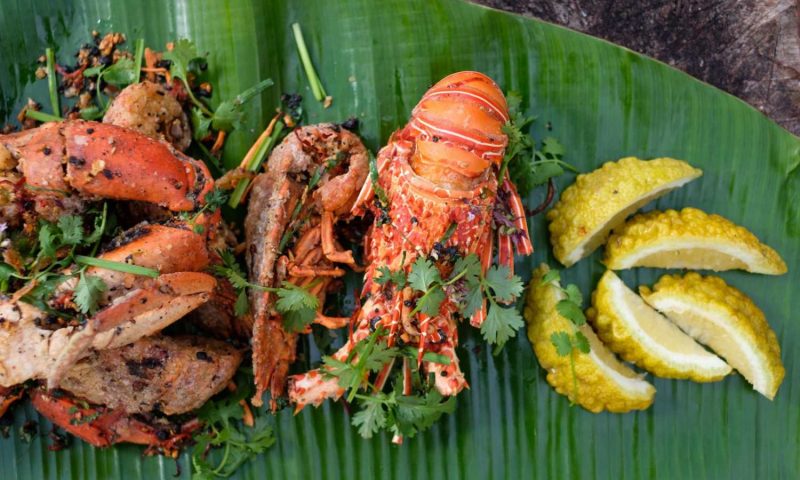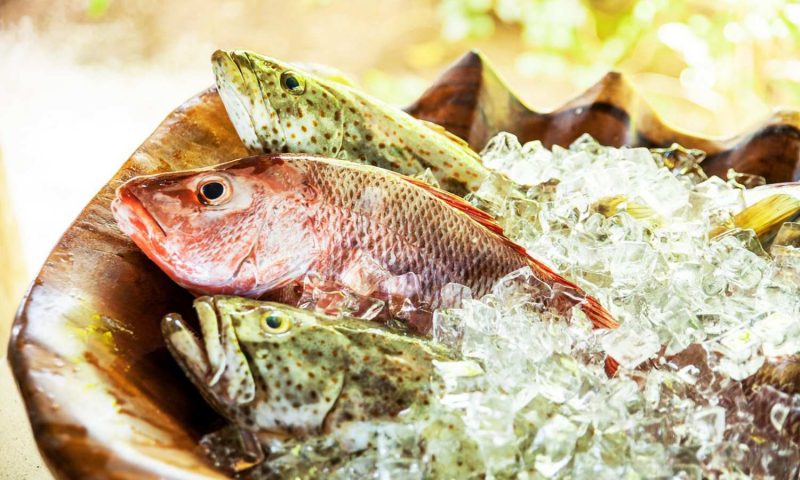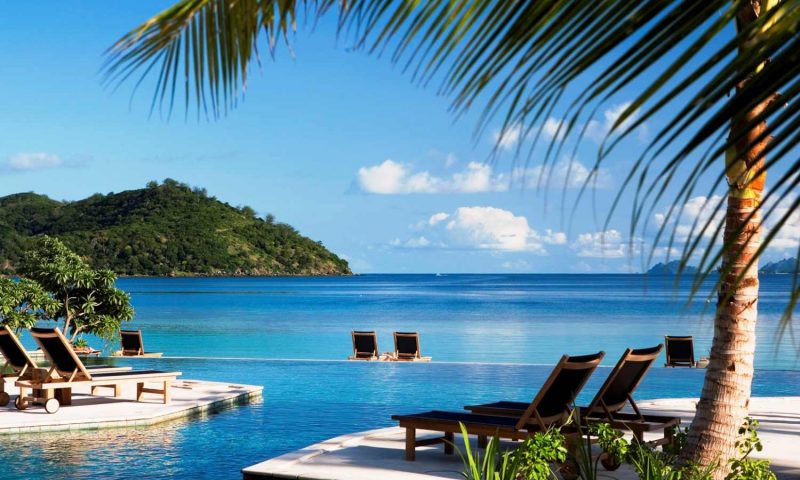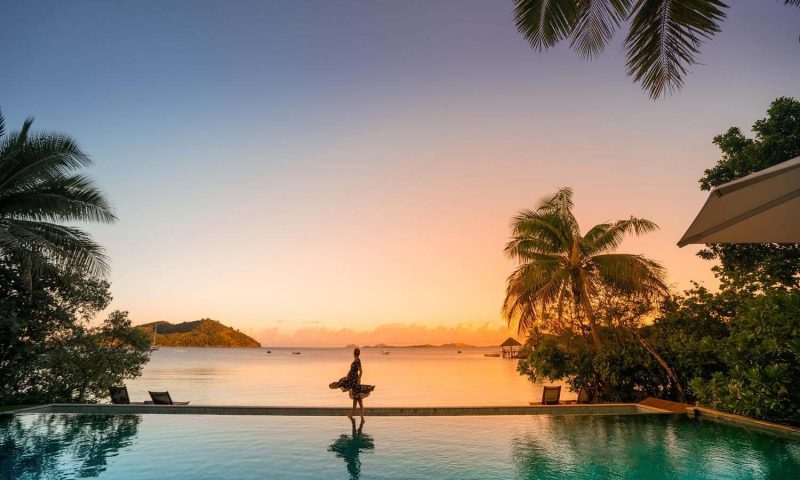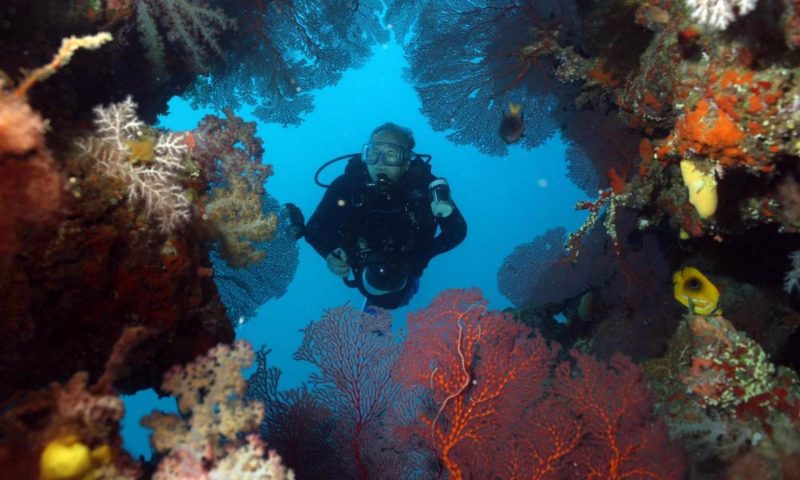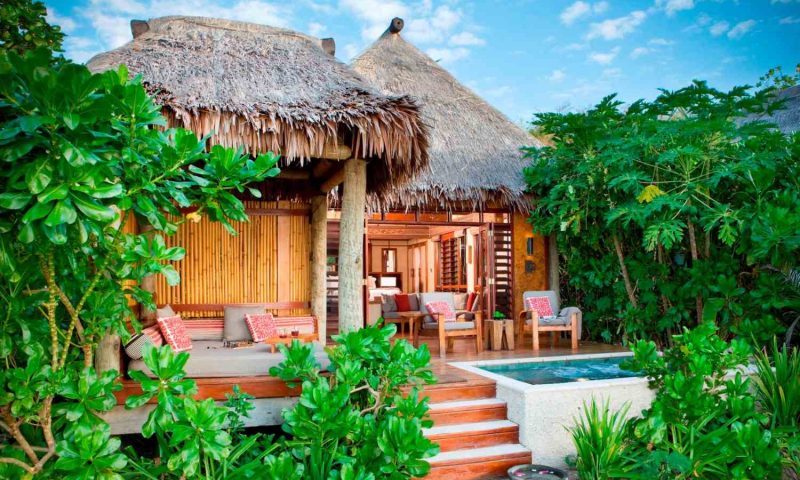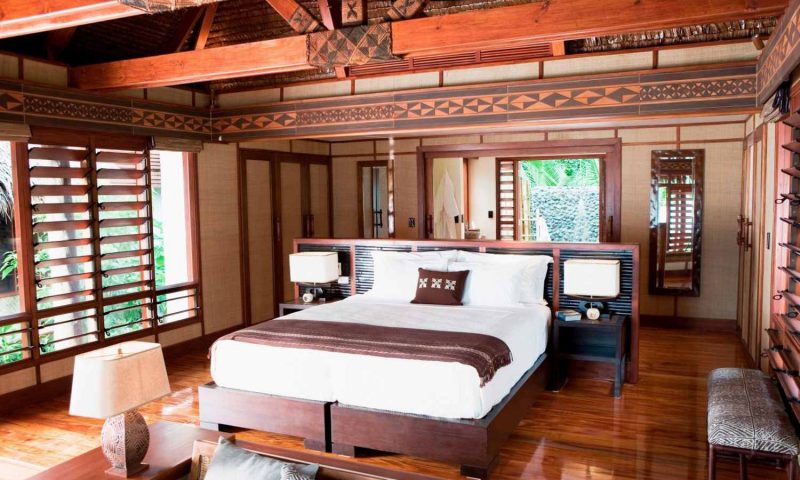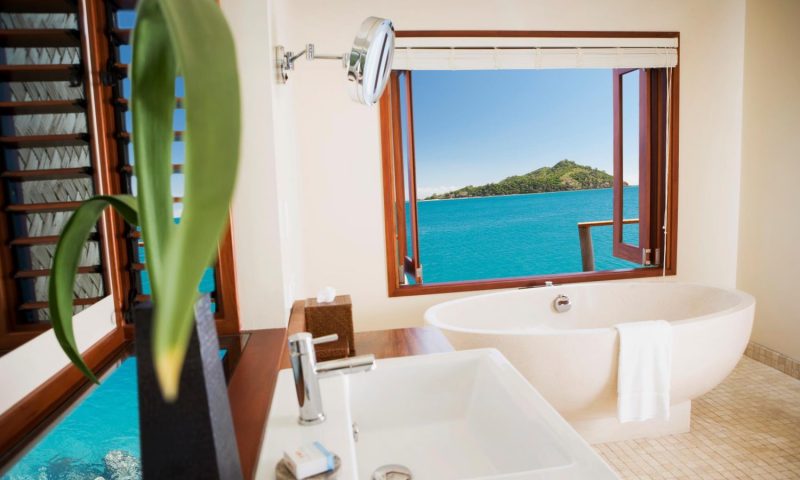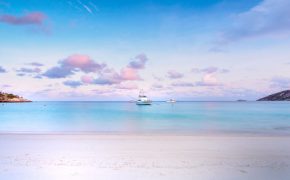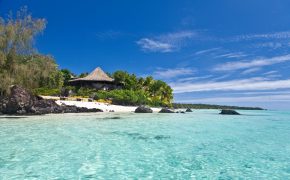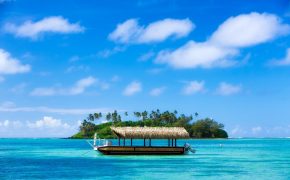Once upon a time across the bluest of oceans, an island was born of lava and sand – an untouched paradise whose heart was a turquoise lagoon of unimaginable beauty and tranquility. The first visitors came and explored. To honour the magic of the place, they named it “Likuliku”, meaning “calm waters”.
Likuliku Lagoon Resort is a haven of subtle luxury for adults only and reserved exclusively for guests in-residence at the resort. A wilderness island retreat, it is the first and only resort in Fiji with authentic over water-bures, in a natural ocean lagoon, surrounded by a protected marine sanctuary.
It is a unique and special place amidst a pristine environment, designed with integrity to Fijian cultural values, traditional designs and architecture, and is embraced by the renowned warmth of the Fijian people.
From the water it looks like an ancient village, so traditional is the style. The beating heart of the Resort is a magnificent building in the design of a Fijian canoe house.
Surrounded by sprawling ceilings, hand-woven thatch and an exotic mix of natural materials and modern elements, Likuliku Lagoon Resort embodies the richness of an ancient culture with vibrant present-day lifestyle touches. Welcome to Fiji’s unique luxury escape for couples. Welcome to your magical sanctuary.
Likuliku Lagoon Resort is located on Malolo Island in the Mamanuca (pronounced mama-nootha) group of islands, 25km/16miles from Nadi International Airport. Meaning “calm waters” in the Malolo dialect, the Likuliku Lagoon is a pristine, natural ecological treasure providing a safe refuge for an abundance of marine life and land flora and fauna.
It is also a place of significant history. In ancient times the Lagoon provided a safe harbour for the war canoes during rough weather, and as a result features prominently in ancient Fijian mythology and folklore. It is an important landmark in the lineage of the Tui Lawa or (Chief of the Oceans).
ACCOMMODATION
The Fijian name for our rooms is “bure”. There are 45 traditionally designed and styled bures, luxuriously appointed and all with views of the beautiful Likuliku Lagoon and ocean.
Each bure has been built with authentic architecture, natural materials and traditional features including local Vesi (hardwood) floors, individual, hand-carved wooden window pelmets and hand-woven “magi magi” (woven coconut husk) art and, Soga (palm) internal thatching woven by authentic artisans from the remote Lau Group of Islands.
Along the beachfront are 35 bures with direct beach and Lagoon access. Eighteen bures have their own private plunge pool, and all beachfront bures have a personal daybed retreat, and private courtyard with secluded outdoor shower.
The 10 unique and spacious over-water bures sit majestically above the coral reef and allow access from their own private balcony straight into the ocean.
OVERWATER BURE
Perched on the edge of the vibrant fringing reef in a natural, pristine lagoon and protected marine sanctuary, these Bures feature traditional architecture and materials using natural elements unique to the region. Elegant and stylish pieces surround you and you wonder at the detail in the woodwork, the “magi magi” designs, and the richness of the fabrics.
Laze on your deck or luxuriate in your separate bathing pavilion with Lagoon views from your grand bathtub. Enjoy your complimentary daily canapé plate from Chef as the living aquarium dazzles beneath you. Likuliku’s Over-Water Bures. Only ten – private, exclusive and beautiful.
DELUXE BEACHFRONT BURE
There are only eighteen of these private sanctuaries on the beachfront, each with their own personal plunge pool and private daybed retreat plus outdoor shower in a secluded courtyard surrounded by lush gardens.
The split-level design optimises the spectacular views over the Lagoon and traditional designs, natural materials and unique, stylish pieces reflect the beauty and history of the South Pacific.
BEACHFRONT BURE
Only a few steps from the beach and crystal clear Lagoon, the Beachfront Bures offer a secluded haven of relaxation and privacy. The 14 Beachfront Bures feature a personal daybed retreat, outdoor shower with secluded courtyard, a spacious deck, traditional Fijian interiors and beautiful Lagoon views. Laze on your deck or stroll along the beach and savour the beauty of Likuliku Lagoon.
GARDEN BEACHFRONT BURE
The three Garden Beachfront Bures are only steps from the beach and Lagoon. Identical to the Beachfront Bures, except these bures are set a little further back amongst the lush gardens and coconut trees, with the island’s natural water-course in front, and beautiful Lagoon views.
DINING
Fresh, clean and creative, Executive Chef Gregory Llewellyn, showcases Likuliku’s cuisine with the finest local and international produce with an emphasis on local seafood, lush tropical fruits, premium product and the diversity of cultures that shape the South Pacific. The hot tropical climate lends itself to simplicity, whilst our market positioning requires a unique, creative style and contemporary flair.
FIJIANA RESTAURANT
Our Fijiana restaurant has been designed with couples in mind. The restaurant comprises four distinct intimate areas that merge into each other creating a unique, distinctly Fijian atmosphere. With stunning views from all areas and an al fresco dining terrace, Fijiana offers a relaxed yet stylish dining experience.
Our food concept is uniquely executed through the expertise and guidance of Executive Chef Gregory Llewellyn. The cuisine is fresh, clean and creative, showcasing the finest local produce with emphasis on local seafood, lush tropical fruits, premium products and the diversity of cultures that have shaped the South Pacific.
Our service culture is professional and attentive with a unique blend of friendly, relaxed Fijian attitude. Full breakfast, lunch and dinner, filter coffee, tea and our island water, are included in the daily tariff. Guests are free to request special dishes or simple and classic favourites, with advance notice, in each dining session.
Personalised menu planning is available for those with specific dietary requirements with notice, including specialty elements of certain cuisine, particularly Indian. Alcohol, soft drinks, bottled water (in addition to what is provided in your room) and Espresso coffees are extra.
MASIMA BAR
Situated on an island in the central lagoon, Masima Bar is open daily for drink service. Serving a list of Fiji inspired cocktails, premium beers, wines and spirits, it is a sanctuary of relaxation with a refreshing ocean breeze, surrounded by the azure waters of Likuliku Lagoon.
Enjoy cosy evenings around the fire pit whilst watching the sun set on another beautiful day in paradise. A selection of bar snacks is available daily.
DUA TALE BAR
Located in the central complex, Dua Tale Bar is Likuliku Lagoon’s cocktail and wine lounge, ideal for pre-dinner drinks and a relaxing reprieve from the Fijian sun. Dua Tale provides a great space to mingle with other guests or chill out with a book and refreshing cocktail.
PRIVATE DINING
For an intimate dining experience, we have two outdoor, beachside decks below our restaurant terrace. Here you can dine under the stars with the musical sounds of the band boys drifting down from above and the beautiful Likuliku Lagoon lapping at your feet. (Please Note: This experience can only be booked on arrival at the Resort.)
For some daytime private romance, why not take a picnic lunch to our own private island – Mociu (pronounced “Moor-thiew”)*. Our picnic lunches are truly something special and the menus are themed to capture the essence of the magical environments surrounding Likuliku Lagoon and its neighbouring islands.
With Fijian, Pacific Rim and Seafood menus available, there is a fabulous range to cater to all needs. Our picnics reflect our attention to detail, from fresh cracked pepper to colour-coordinated napery and tableware. A full range of beverages is available to complement our picnics. Please enquire at the Resort on arrival. (*subject to availability).
For special occasions and small, intimate group gatherings, you can experience our Private Dining Room. Catering for up to 20 guests, this room is ideal for weddings, small group dining, cocktail parties and small meetings.
A spacious wrap-around outdoor terrace with views over the Lagoon and natural green habitat is perfect for that pre-event cocktail party. Contact our events coordinator for further information.
WEDDINGS & SPECIAL OCCASIONS
Likuliku Lagoon Resort is the perfect location to celebrate a wedding, honeymoon, renewal of vows or anniversary. Special Wedding and Romance Packages are available and our dedicated Likuliku Wedding Service will ensure that your most special of days is unforgettable.
Your special occasion can be customised to accommodate any special needs or individual wishes and include a choice of romantic ceremony locations such as the beach at sunset, around the magnificent horizon-edge pool or on the deck of your over-water bure.
INCENTIVES, MEETINGS & EVENTS
Imagine a place, steeped in the history and traditions of an ancient culture with a resort built to look like an authentic Fijian village of old. Imagine this place for your special event – a unique experience like nothing else in Fiji.
Celebrate your corporate success with a memorable incentive travel or meeting experience at Likuliku. Ideal for small, intimate groups, or during select times of the year, the entire resort could be exclusively yours.
TATADRA SPA
Luxurious and tranquil, it is nestled against the green slopes of the island with beautiful Lagoon views and soothing breezes. Drift into relaxation and a dream-like state with a Fijian-style massage or select any number of natural beauty and body treatments to soothe your soul from the range of beautiful and naturally crafted “Pure Fiji” spa and body products.
GYMNASIUM
Your fitness regime does not need to be interrupted just because you are on holiday. The Likuliku gym is accessible 24/7 and is located in a converted Beachfront Bure. It offers a compact but comprehensive choice of equipment to keep your workouts on track.
CONSERVATION & SUSTAINABILITY
We live and operate in a pristine but fragile ecosystem that traverses both sea and land. As a Resort company operating in such a pristine sensitive environment we support wholly the concept of sustainable tourism and believe that any development in such areas carries not only a legal but also a moral responsibility to ensure that the environment is not degraded through irresponsible activities and practices.
Sustainable tourism is also about the people and the culture. It is about providing livelihood opportunities for improving and helping island communities and individuals through the development of businesses that provide jobs, training and on-going development without compromising or taking advantage of the culture or the people involved.
Ahura Resorts is an equal opportunity employer. We are a family business, 100% Fijian owned and have strong personal ties with the land, the sea and the people of Fiji. Our Resorts are built on land that has a 99-year lease. Royalties are paid to the Landowners as well as a monthly rental calculated on a percentage of all sales. Ahura also provides an education fund for the landowners.
HISTORY & CULTURE
Likuliku in the Malolo dialect literally means “Calm Lagoons or Waters”. It was an ancient safe harbour for the war canoes during times of tribal warfare.
Likuliku features prominently in ancient Fijian Mythology and History and is an important landmark, not only in terms of the history, but in the importance the site plays in the lineage of the “Tui Lawa” (Chief of the Oceans). Step inside the Legend of Likuliku.
The history of Fiji, according to mythology, begins about 1500 BC with a voyage of giant war canoes from Taganika north of Egypt. Leading the armada on the giant double hull canoe “Kaunitoni” was the able seafarer warrior Chief Lutunasobasoba assisted by his General Degei.
Legend has it that the armada was carrying some special cargo – treasures from the Temple of King Solomon in Judah including a special box called the Katonimana (Kato meaning case and Mana being magic), which in Fijian literally means the “Box of Blessings”.
The purpose was to find a mythological island in the South East with bountiful seas and rich land created by the Gods where the Chief ’s people could rest after years of wandering. Navigation was by the evening stars. The armada carried rations, families, warriors and skilled craftsman including Lapita Potters.
Two convoys set sail, but one got separated and disappeared in the Indian Ocean. The other continued South East past Indonesia, Papua New Guinea into the Marquesas, north of Tahiti, then curled back south west into the Fiji group of islands.
Legend has it that the armada travelled via the Yasawas and as the reefs were treacherous around Vita Levu, they had to keep travelling South West to find a passage, an “opening” to enter the Fiji Waters. This passage was the Momi passage which is still used today by large ocean-going vessels.
It was here around Matamanoa, Mana and Likuliku, that the giant outrigger canoe Kaunitoni with its special cargo, met inclement weather and high seas. Due to seas, the Katonimana the “Box of Blessings” slipped off the outrigger canoe. Lutunasobasoba gave orders to let it go, believing it was the will of the gods. The General Degei tried to retrieve it but it was too late.
Lutunasobasoba then named the three islands, Mata-manoa (Mata means eye, Manoa means wind) which literally means “eye of the strong wind”, the other island Mana means magic, to mark the area where the box of blessings fell, and Likuliku because it was here the armada experienced calm waters again.
The convoy finally landed at Vuda Point, a beach quite near Nadi Airport on the big Island of Viti Levu. The Chief Lutunasobasoba eventually settled in Vaturu which is one of the high mountains you see outside Nadi Airport and Degei eventually moved to Nakauvadra near Mount Victoria.
Lutunasobasoba gave specific instructions that no one was to ever try and retrieve the Katonimana that was in the Mamanuca seas. The gods made their decision clear that it was to remain in the Mamanucas and anyone who tried to tamper with the box would be cursed.
Lutunasobasoba also predicted that this group of islands would be a great source of prosperity for the Fijian people in the future. Degei many years later returned to the Mamanucas to try and retrieve the box of blessings.
Legend has it that he only managed to retrieve a big diamond which was outside of the box. Immediately he was cursed and transformed into a snake with the diamond marked on his head for eternity.
For the rest of his life he would crawl on his stomach, wearing a heavy diamond and be trapped in an ocean cave in Sawa-i-lau in the Yasawas, which is accessible to visitors today.
The Fijians believe that this box is still buried today in the oceans between Likuliku and Mana guarded by two giant clams. It is this box that they believe has brought great blessings to all the villages in the area and the people who visit the islands. So if you enter the waters around Likuliku, keep an eye out for this special box.
Most authorities agree that the people came into the Pacific from Southeast Asia via Indonesia. Here the Melanesians and the Polynesians mixed to create a highly developed society long before the arrival of the Europeans.
The European discoveries of the Fiji group were accidental. The first of these discoveries was made in 1643 by the Dutch explorer, Abel Tasman and English navigators, including Captain James Cook who sailed through in 1774 and made further explorations in the 18th century.
From 1879 to 1916 Indians came as indentured labourers to work on the sugar plantations. On completion of their indentured term, these labourers had the opportunity to return to India but most chose to remain in Fiji and establish small farming units After the indentured system was abolished, traders, priests and different castes arrived to help establish an integrated, hardworking and subsequently often prosperous 45% of Fiji’s population.
MALOLO – THI ISLAND OF THE RESTING SUN
The island of Malolo on which Likuliku is located, is also steeped in history and legend. The early settlers, after working the rich land and bountiful seas, would cast their eyes to the west each afternoon as the sun would always set behind Malolo Island.
From a distance, it appeared as if the sun was resting. The Fijians believe that Malolo was an island especially created by the gods where the sun would come and rest after a day of wandering. From that time Fijians branched out from Viseisei to occupy over half of our 300 beautiful islands in the group.
But every Fijian, irrespective of what island they hail from, knows that at the end of the day, wherever you are in Fiji, the sun will always come to rest on Malolo Island.
Ancient expressions such as “All roads lead to Rome” have entered our everyday English language. For the Fijians, the expression “na siga e dromui Malolo” has also become part of everyday Fijian sayings. It means “Malolo is where the sun comes to rest”.
SHELTERED WATERS
Likuliku Lagoon features prominently in ancient Fijian mythology and history. It is an important landmark not only in terms of the history, but the importance the site plays in the lineage of the “Tui Lawa” (Chief of the Oceans).
It was an ancient safe harbour for the war canoes during times of tribal warfare. Extensive research on the area was carried out in September 2004 based on discussions with the paramount chief of the Mamanucas and village elders, study of archives in the National Museum in Suva and past studies carried out by archaeologists.
SACRED & ARCHAEOLOGICAL SITES
Likuliku is surrounded by some significant and important archeological and sacred sites, most of which can be visited during your stay at the resort.
YADRA CAVE
The original village of Yaro was located in Likuliku about two centuries ago before being relocated to its current location. On the lease, the headland is marked as “Sacred Rock”.
Before Christianity, the special clan of the “Bete”, the ancient Fijian priests from the village of Yaro, would make traditional sacrifice to the Sea Gods using kava roots and produce from the land at certain times in the lunar calendar.
On the headland is a magic wishing cave occupied by the “Kalou Vu” (spirit god), that is said to be able to bring great blessing and grant all your dreams and aspirations. The cave can only be accessible by the Bete, and no-one else.
Villagers would petition the village elder with a request – for example, to have good crops this season, a child for newlyweds, good weather during a long sea journey, etc. The village elder “mata ni vanua” would present a kava root to the Bete, who would in turn visit the cave to present the petitions.
If requests were made with noble intentions, the wish would always be granted. When plans for the development of Likuliku Lagoon were being made, the village elders requested that the rock be marked a “Ni Sa Tabu” site meaning a sacred site.
No development will ever occur on this headland. “Yadra” in Malolo dialect is new, and Vula is moon, and “Vatu Tabu” means sacred rock, so the area is translated “The Sacred Rock of the new moon”.
KI NI WAI
Literally meaning “keys to the ocean”, this is a sacred site where the paramount chief of all the Mamanucas “Na Tui Lwa” (Chief of Lawa) would be installed. In his installation he would be given the “keys to the ocean” meaning his paramount control of all the land and ocean resources in the Mamanuca area.
The ancient village of Yaro Lawa, was located originally on Likuliku before moving to its current location. It is also believed a magic walking stick “titoko tabu” is still buried in this location. This stick was used to separate the original Malolo Island into two islands: Malolo and Malolo Lailai (lailai means small). It has power over the elements.
Some believe the magic stick was from the magic treasure chest located somewhere between Mana and Likuliku. (Refer: Legend of the Magic Box). The Fijians believe that at dead midnight, a large star would always hover over this site, a symbol of the presence of the “titoko” and its influence on the elements and importance of the chiefly location.
VATU TAGI
This legendary rock makes a ringing or wailing sound when struck, a sound that is completely different from other rocks around it. The rock is located on the left of the large black rocky outcrop behind Likuliku Beach, and it sits under the vaivai tree on a long flat black rock.
This rock was used by village elders of the Tui Lawa (Chief of the Oceans) as a sign of sending messages for meetings to be held around Likuliku. If a lali (hollow wooden log) is beaten close to the rock, its sound echoes around Malolo Island informing the elders to convene for a chiefly meeting.
MOKA
Moka literally means “fish trap”. Characterized by its soft soil, it is known to the fisherman’s clan as a way of trapping fish moving along the coastline during high tide. There is a lot of moka around Likuliku but the “old moka” used by turaga Ratu is located here.
It is close to the old village site and the main use was in a “fish drive” by turaga Ratu. Turaga Ratu also used this place as a trap for enemies when they tried to attack the old village of Yaro.
CUSTOMS & PROTOCOL
Fiji is well known for its customs and culture. If attending one of our village trips, it is wise to learn a little more about the Fijian customs before leaving.
Firstly the dress code is casual, but shorts and a T-Shirt must be worn by both men and women to ensure shoulders are covered. Women should also cover their legs with a sarong or sulu: it is considered impolite to wear hats or carry a backpack into the village.
At the Community Hall you will be greeted by the village chiefs and elders. A sevusevu or gift is presented to the chief and village elders, normally yaqona, which is the root used to make the traditional welcome drink. The Chief who will be seated on the top centre of the room will receive the first bowl of yaqona, which is also known in the South Pacific as kava.
It is customary to clap three times after he has finished drinking. It is also customary before receiving a bowl of kava to clap once and then clap three times after you have finished. Everyone in the Community Hall gets to taste the kava.
To clap is to show a means of respect to the elders. It is TABU (forbidden) to wear a cap or hat in a Fijian house and shoes should be removed before entry. It is also extremely rude to touch a Fijian on the head at any time.
MARINE PARK
Fiji has 10,020 square kilometers (3868 square miles) of coral reef, 385 sq kilometers (148 sq miles) of mangrove plus large tracts of island rainforest. There are over 398 coral species with 9 mangrove species in Fiji together with more than 1200 varieties of reef fish and countries invertebrates.
Several species of turtle, including Green, Hawksbill, Leatherback and Olive Ridley are found in Fijian waters, along with rare sightings of Dugongs and migratory sea routes for cetaceans, such as Humpback Whales. Undisturbed islands in Fiji are crucial nesting grounds for seabirds like reef egrets, petrels and terns.
CORAL REEFS
Coral reefs are living structures composed of millions of coral colonies growing on and around each other, creating niches for thousands of other creatures – from fish and crustaceans to worms and mollusks.
The reef has a framework of limestone that the corals deposit themselves – rather like a skeleton. Each coral consists of a colony of tiny anemone-like polyps. These can catch floating particles of food, but most corals rely on symbiotic algae living inside them to provide food through photosynthesis.
This explains why coral reefs thrive in shallow, brightly lit seas. Coral reefs are also sensitive to temperature. They prefer water between 18-30 degrees Celsius (64-88F) restricting them mainly to the tropics.
Fiji’s reefs are recognised as some of the most diverse in the world, and their survival is crucial for many reasons. They support 398 coral species and 1200 varieties of fish.
As such they have provided the local inhabitants of the islands with a valuable source of food and the reefs of Fiji have been sustainably harvested for millennia using wisdom passed down through local knowledge and custom. The reefs have also become a crucial asset to Fiji’s tourism which accounts for nearly 50% of the Fijian economy.
Coral reefs provide homes for more than a third of the known fish species and a myriad of other sea creatures. They are nature’s own front line defences protecting coastlines from storms and floods and they are also a source of medical compounds for treating leukaemia, skin cancer and cardio vascular diseases.
Coral reefs are threatened by commercial overfishing which is forcing many subsistence fishing communities to resort to poison, dynamite and other destructive methods to collect what little food is left.
Fish and crustaceans are caught too young and natural breeding cycles interrupted. Reefs are also damaged by smothering run off from rainforest clearance, pollution, irresponsible tourism activities and climate change leading to rising seawater temperatures lethal to corals.
THE REEF AT LIKULIKU
At Likuliku we are surrounded by a beautiful and fragile coral reef eco system that is a protected marine sanctuary. While the lagoon and ocean around Likuliku are safe to swim and have fun in, please be aware that coral takes decades to grow (on average one to five centimetres a year) and only seconds to be damaged by stepping on it or brushing it with your flippers.
MARINE RESERVE “NA TABU”
On the 19th July 2005, the Paramount Chief of the Mamanuca Islands, Na TuiLawa, declared the waters and reefs in front of Likuliku Lagoon and Malolo Resort as a new marine reserve.
The marine reserve is an environmental initiative of Malolo Island in partnership with the traditional owners to improve the fish stocks and allow the natural regeneration of reef and marine life as part of responsible and sustainable tourism.
This Tabu means that any form of fishing or shell fish collecting is an offence and is strictly forbidden in the designated areas and applies to everyone, visitors and locals alike. As members of the Mamanuca Environment Society (MES) we are delighted with this decision.
Wherever you see a pole sticking out of the water with a palm frond across the top it means that the surrounding area has had an official Na Tabu ceremony and is now a restricted marine park area.
AQUATIC LIFE
The fringing reefs at Likuliku Lagoon are ideal for snorkelling and many hours can be spent exploring and observing a myriad of aquatic life. Some of the fish you may well see can be found here in the Likuliku Fish Identification Chart.
Whilst swimming, snorkelling or diving, you will see a myriad of marine life including the occasional friendly reef shark. These are mostly less than 90cm (3 ft) long and are harmless.
They will be more afraid of you than you are of them and generally swim well below your deepest diving depth. Small stingrays occasionally venture into the lagoon and it is wise to tread carefully if wading in the shallows.
Scorpion fish, stone fish and Lion fish are also sometimes found on shallow reef as are cone shells and fire coral. The banded Sea Krait sea snake is common around Malolo Island. They are extremely venomous but docile and non- aggressive animals. If you discover one, watch from a distance or move away calmly.
Small patches of tiny jellyfish are also found around the reef at certain times of the year. They are often mistakenly referred to as sea lice and while they may give pin-prick stings they are not dangerous.
TURTLE BREEDING GROUND
Likuliku Lagoon is a designated turtle breeding ground and at certain times of the year you will see evidence of turtle activity in the sand and certainly may spot these majestic creatures swimming in the lagoon.
FLORA
The islands of western Fiji are home to the dry forest. Over the years, the vegetation of the Yasawa and Mamanuca groups of islands has suffered extensive alteration, primarily through fire, clearance and cultivation, and secondarily through cyclones and the spread of invasive alien species.
Dry forest eco systems are now classified as one of the most endangered eco systems in the world. Today Malolo Island only retains a mere remnant of its original vegetation. However, behind Likuliku’s beach, is the largest remaining area of Dry forest on Malolo.
There are some fine native trees remaining including Stinkwood wiriwiriGyrocarpusamericanus, Coral Tree drala Erythrinavariegate, Chinese Lantern Tree evuevu Hernandiapeltata, buabua Guettardaspeciosa, Milo mulomulo Thespesiapopulnea, Ironwood vesi Intsiabijuga, tarawauni kaka Dracontomelonvitiense, Beach Almond tavola Terminaliacatappa, Beach Laurel or Beauty Leaf dilo Calophylluminophyllum, Fish-poison Tree vutu Barringtoniaasiatica, Pisoniagrandis and bau Planchonella/Burkella. Some large mango trees can also be found at the base of the hill slopes on the southern side of the Resort.
Two “character” trees have also been identified – a magnificent, large baka or Fig Tree at the back of the forest area and a large Dilo which stands on the beach outside Bure #44. Both are major landmarks.
The baka is truly a majestic tree and a remnant of the former forest on the island. Such figs are keystone species with respect to forest ecological processes by retaining this tree, we have assisted in the future rehabilitation of original habitats.
The Dilo is a fine, old tree which has survived many cyclones over the years and fires. This tree is also a beautiful remnant of the former forest and a delightful place to sit under the protection of its huge canopy.
As part of Ahura Resorts environmental program, we have a Dry Forest Regeneration Program in place in conjunction with the Ministry of Forestry and other local authorities.
There are also two stands of healthy mangrove at the resort, a single offshore stand at the northern end of the beach, and a larger formation along the internal watercourse which flows through the island which has been designated a Preservation Area.
FAUNA
There is one significant Malolo Island native still surviving – the Fiji Crested Iguana or Brachylophus Vitiensis. This species is on the endangered critical list (ICUN 2006). They are the Panda Bears of Fiji in terms of their level of being critically endangered.
In 2011 three juvenile iguanas were discovered on the resort. This has caused great excitement locally and internationally and we now work closely with the Local Government agencies as well as Fiji Iguana specialist Kula Park in Fiji and specialists from Taronga Zoo in Sydney Australia and San Diego Zoo in the USA. In the last fiver years, we have found many more Iguanas to add to the family and also now have a breeding pair.
Several reasons can be attributed to the drastic diminishing number of Fiji Crested Iguanas. The main one is the loss of their natural environment ie Dry Forest, and the introduction of cats and goats to the islands. You can learn more about our complete program and conservation efforts here.
As part of the Ahura Resorts environmental program we have a Permit to catch and protect Iguanas found on the lease area. We work closely with our partners to protect the Iguanas with the ultimate aim of setting up our own breeding and release program. (see Ahura Resorts Environmental Policy).
Other animals native to Fiji and the Dry Forest eco system that are on the endangered critical list are the Bolo snake and Pacific boas. In all, there are about 80 species of terrestrial and freshwater birds in Fiji of which about 10 have been introduced.
There are three species of hawk in Fiji. The most common is the Pacific Harrier, seen on Malolo Island, and also most commonly seen over grasslands, swamps and wooded areas. It feeds on rodents, birds and occasionally snakes. The Fiji Goshawk, also seen on Malolo, ranges from the coast to inland areas and preys on lizards, insects and other birds.
There are several varieties of dove in Fiji. Seen on Malolo Island and the most common, is the introduced Spotted-neck Dove. Another Malolo resident is the White-collared Kingfisher – it is striking blue with a white collar around the neck and is often seen ‘dive bombing’ water areas like pools and lagoons to fish and eat.
Much less exotic is the Indian or House Mynah which was introduced in the late 19th century to feed on sugar cane pests. Aggressive, intelligent and noisy, it can be seen throughout Fiji and on Malolo Island. It is sad that with the massive reduction of the Dry Forest eco system, the Whistling Tree Duck and the Grass Owl are now extinct.
ACTIVITIES
We offer a daily-changing schedule of activities, including complimentary non-motorised watersports such as stand-up paddle boarding, kayaking, sailing and wind surfing, plus complimentary snorkeling equipment. In addition, there is a myriad of land and sea tours and activities available in and around the surrounding Mamanuca Islands.
SNORKELLING
The islands of the Mamanucas are rich with coral reefs and a vast variety of amazing tropical fish. Likuliku Lagoon and Malolo Island are surrounded by a fringing coral reef making snorkeling ideal.
If you want to venture further afield and explore other snorkel sites, we offer daily trips to various sites nearby and sometimes you may even end up in an undiscovered part of the islands, seeing amazing marine life for the first time.
FISHING
Within the immediate area surrounding Likuliku and Malolo Island, there is a marine reserve and fishing is strictly forbidden. However, we do offer a variety of fishing excursions to areas where keen anglers can troll for Tuna or perhaps a Giant Trevally.
Also, Dog Tooth Tuna, Mahi Mahi, Wahoo, Rainbow Runner, Barracuda, Coral Trout, Scad and Billfish are just some of the fish that swim our waters. In line with our Sustainable Tourism Policy we do not actively fish for Marlin or Sail Fish. In the event that one is caught it is our Policy to “catch and release”.
SURFING
Close to the Resort are some of the world’s most famous surf breaks found along the southern part of the Malolo Barrier Reef. We offer surf tours to internationally acclaimed Cloudbreak, Wilkes Passage, Desperation and Restaurants. Daily trips can be taken from Likuliku – talk to our Activities team for more information.
WALKING & HIKING TRAILS
There are several walking trails varying in length and difficulty from the resort. Our walks currently include Jona’s Lookout with magnificent views over the resort and island waters, the Ridge Track to Naroba Point and the highlight is the trek to the top of Malolo Island – Mt Uluisilo – the site of an old WWII American Fort.
FIJIAN CRESTED IGUANA EXPERIENCE
Join the Resort Environment Manager for a presentation on the history of the Iguana in Fiji, on Malolo Island and specifically on the Resort leases; how the species has been saved on Malolo, and what has and is being done to ensure the survival of its habitat and other biodiversity.
This will be followed by a personalised tour of the Resort’s Iguana Sanctuary, Breeding Cages, and Dry Forest Habitat.
VILLAGE TRIP
Here you will experience how our indigenous land owners live at the local chiefly village of Yaro. Your trip begins authentically as the local villagers travel – in a long-boat from the resort in a short 15 minute trip to around the other side of the island.
You will meet the locals – some of them will be the family of many of our resort staff – and learn the history of the area, island and the village. Dress code: In the village modesty is important, there is a dress code – no short dresses, swimwear or shorts and all guests must wear a sulu/sarong. No hats are allowed to be worn when walking around the village.
ISLAND HOPPING
Often the best time to be on the water is in the early morning before the wind picks up and it is certainly the best time for an early morning island hopping trip. We take you past Castaway Island, Mana Island, Matamanoa Island and finally MonuRiki Island where we stop for a swim, snorkel and walk along the beach.
MonuRiki Island is one of the most stunningly beautiful islands in the Mamanucas and is where the famous “Cast Away” movie with Tom Hanks was filmed.
The trip then heads north around Monu Island, west round the top of Yanuya Island, past Tokoriki Island before turning south for the return trip past Tavua Island and before heading back for a late breakfast at the resort.
SUNSET CRUISE
Malolo is referred to by the local Fijians as “Na Siga e dromu I Malolo”. Translated this means “That place where the sun comes to rest.”
The sunsets from Likuliku can be quite magnificent and what better way to enjoy the scene than from one of our sunset cruises whilst sipping a glass of sparkling wine, enjoying Chef’s canapés and listening to the sounds of one of our Likuliku serenaders as you sail around the island.
MOCIU PRIVATE ISLAND (HONEYMOON ISLAND)
In 2018 we secured the lease of Mociu Island (pronounced “Moor-thiew”). A private, tiny, uninhabited island only 15 minutes boat ride from the resort, Mociu is a protected nature reserve and the waters and reef around it have been declared a marine “na tabu” by the Paramount Chief of the Mamanucas – meaning no form of fishing or shell fish collecting is allowed.
Mociu Island is for the enjoyment of Ahura Resorts’ guests only and will also be used to further develop and expand our environmental initiatives including: dry forest restoration, coral/clam and other marine transplanting and preservation and other bio-diversity protection. Access to the land is by invitation only. More information.
WET WEATHER PROGRAM
We do occasionally get rainy days in Fiji. But this won’t stop you from enjoying a walk in the rain or even a swim or a snorkel. Alternatively take the time to catch up on some reading or watch a DVD in the comfort of your room.
We also run a wet weather program usually in the Dua Tale bar. Here you can join the activities team as they demonstrate the many ways to tie a Sulu/Sarong, learn to weave baskets and hats from palm fronds, learn some Fijian and hear about the Fijian culture and some of the famous island legends while sampling a bowl of Kava (Yaqona).
MEKE & LOVO
Friday nights be entertained by members of staff who will perform the traditional Meke (dance). Here you will experience traditional stories through dance and song. This is followed by dinner of the traditional Lovo (earth oven feast) and South Pacific BBQ.
KAVA CEREMONY
The drinking of Kava is an important Fijian tradition. Join the activities team for a traditional Kava ceremony at Masima Bar. Learn about the origins of Kava, the plant and its attributes and the protocols surrounding the ceremony itself.
DIVING
Our Dive Centre is operated by Subsurface Fiji, a PADI 5 Star IDC. A short boat ride away and just below the surface is another world. A world of vivid turquoise waters, abundant with beautiful hard and soft corals, teeming with an amazing variety of colourful reef fish.
Choose a relaxing dive in the calm inner reef waters or explore the deeper ocean side Mamanuca barrier reef where dolphins, manta rays, turtles and large pelagic fish are your dive companions.
For certified divers, we will take you to a choice of 44 dive sites in the Mamanuca Islands. Expect to see caves, pinnacles, walls, a crashed B26 Bomber from WW2, a ship wreck and experience the shark encounter dive at the world- famous ‘Supermarket’dive site.
Add in an abundance of tropical fish, large pelagic fish, and the colourful soft corals that Fiji is famous for and you will want to keep exploring these magnificent reefs. Dive trips depart daily.
LEARN TO DIVE
PADI DISCOVER SCUBA DIVING. Half-day introduction to scuba diving. Learn the scuba basics in the pool and then it’s off to dive the world famous reefs with the guidance of your dive instructor.
PADI OPEN WATER DIVE COURSE Learn the fundamentals of scuba diving, including dive equipment and techniques. In just two and a half days you can get the certification for a lifetime of diving adventures
ADVANCED COURSES
ADVANCED OPEN WATER. Expand your skills, confidence and experience. Over two and a half days you will complete five open water diving specialties, under the guidance of your instructor. There are numerous specialties to choose from.
RESCUE DIVER COURSE. Rewarding and fun. This two- day course teaches you hands- on, life- like situations – how to prevent and manage potential dive accidents. These skills will make you a better dive buddy
PADI SPECIALTY PROGRAMMES. Extend your skill and knowledge with a PADI specialty course, and work your way to becoming a PADI Master Scuba Diver. Numerous courses to choose from.
